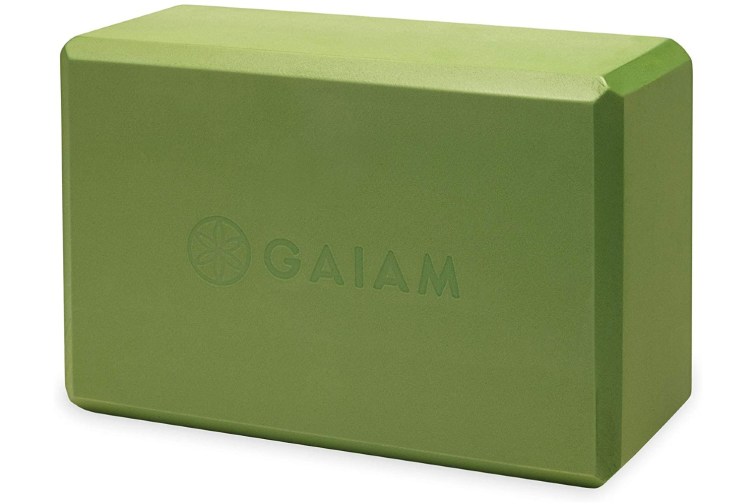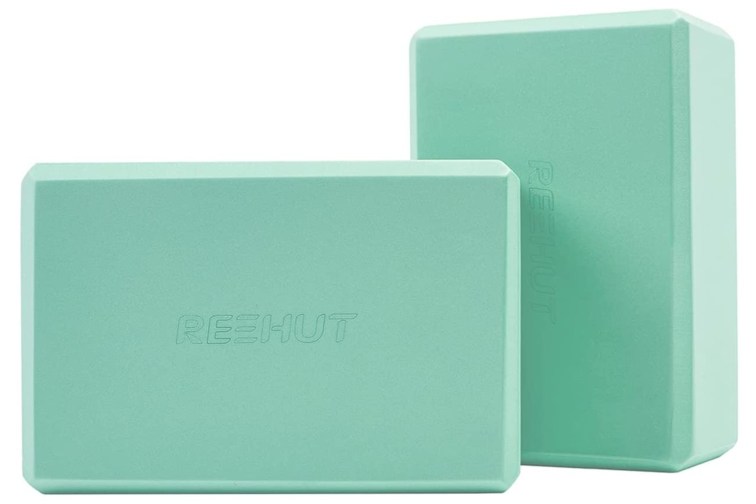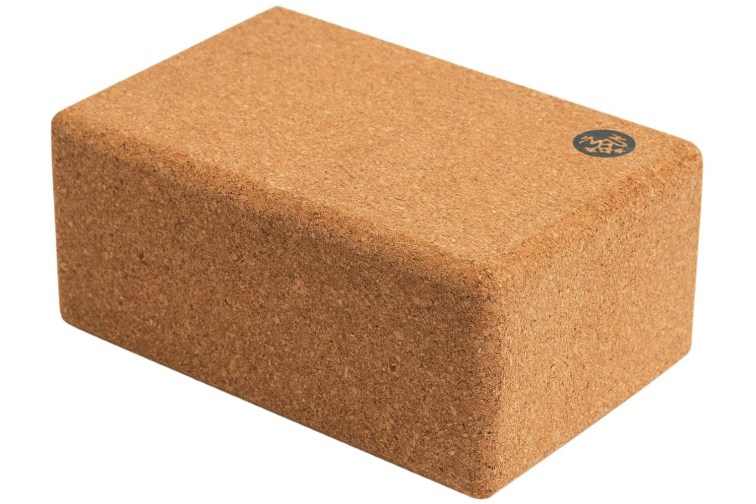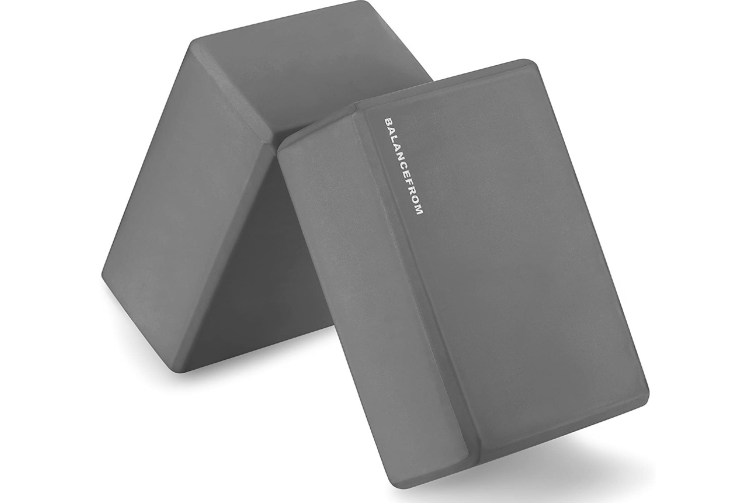If you purchase an independently reviewed product or service through a link on our website, we may receive an affiliate commission. Learn more about our policies and reviews.
Whether you are a newbie to the practice of yoga or an advanced yogi, incorporating tools, accessories, or props into your daily routine will help take your practice to the next level. Yoga blocks are one example of a popular yoga tool that is often used as an extension of the arms and to help extend, support and deepen your stretches while also working to increase your range of motion.
Yoga blocks are most commonly made from foam, bamboo, wood, or cork and come as a single block or in doubles. The material of a yoga block is pure preference, depends on your level of flexibility, how heavy or light you prefer your blocks, and which one makes you more comfortable.
Below are some great yoga blocks on Amazon that will safely allow you to reach deeper into your poses while helping to maintain proper form and alignment. They come in a wide variety of colors that you can mix and match with your mat and cute yoga attire and work great in a class, studio, and at home.
Our Favorite Yoga Block Worth Considering in 2024
Gaiam Yoga Block — Best Overall
Gaiam’s Yoga Blocks are the ideal prop and an important tool in any yoga practice to help extend, support and deepen your stretches while also working to increase your range of motion. These lightweight blocks are made from durable and supportive foam with a non-slip surface and beveled edges for easy gripping. One great use of these blocks is for when you are feeling tighter than normal and need to rely upon a little bit of help to get through and enjoy your yoga session.
Pros
- Spot clean with mild detergent and towel or air dry
Cons
- If you prefer a highly dense block, another option might be better
REEHUT Yoga Blocks — Runner Up
Reehut’s Yoga Blocks come in a set of two that can be used separately or stacked together to create a greater range of possibilities for extra height and support. These blocks are a higher density option than the one listed above and will provide reliable support even under considerable weight. Perfect for yoga, pilates, or your daily physical therapy exercises, these blocks feature a slip-resistant surface and have a large enough surface area to comfortably sit on during more extensive yoga poses.
Pros
- These blocks come with a 60-day, money-back guarantee, and 18-month replacement option
Cons
- There might be a slight odor upon opening which will go away
Manduka Cork Yoga Block — Honorable Mention
Another popular material used in making yoga blocks is cork. Cork is a great yoga block option as it is a sustainable, natural material that has a firmness not found in foam, allowing you to feel secure in the support it provides. The Manduka Yoga Block is made from 100% cork, has an easy-to-grip, textured surface, and its comfortable, contoured edges help accommodate you during even the toughest of stretches.
Pros
- As cork is a natural material, no toxic chemicals are produced in their harvesting and manufacturing
Cons
- This is a heavier block and if you prefer a lighter material, another option might be better
BalanceFrom Yoga Blocks — Contender
The BalanceFrom Yoga Blocks are another set of two high-density foam block options to help deepen and elongate your stretches and align your posture perfectly. Ideal for all fitness levels, these lightweight blocks are perfect for the on-the-go, in the studio, at the gym, and are perfect for at-home use. These blocks also have a slip-resistant surface to prevent slipping and sliding during use, rounded edges for a comfortable and steady grip and its moisture-proof material keeps bacteria away.
Pros
- These are available in seven colors to mix and match with your yoga mat
Cons
- If you need only one block another option might be better
Buying Guide: Yoga Blocks
You must have seen these bricks known as yoga blocks at a gym, class, or park. Well, these so-called bricks can help you elevate, balance, and comfortably perform different exercises in yoga. These blocks were first used in the USA and were made out of wood. Later, they were manufactured using other materials too. Today they are essential parts of one’s yoga gear. It would help if you considered a few things before buying this block, like the size, material, and the fact that you even require a yoga block. Read on to find out how to choose the right one!
Most Popular Yoga Block Materials
Foam
Yoga blocks made from foam are the most popular ones today. You may have seen these in different places before. The reason for the popularity of this material is that it is affordable to buy and most suitable for beginners. Moreover, foam comes in different colors, making it attractive, unlike other materials. Another advantage of foam is that it doesn’t slip and is soft to touch. A common opinion is that this material does not last as long as the other materials; however, that’s not true. A yoga block made from high-quality foam will surely last longer than one expects.
Wood
Next, we have the good old wood. It’s solid, durable, and can be easily cleaned. Furnished wood is an excellent material for yoga, as it indicates calmness. Its toughness can be utilized for exercises that build strength. On the other hand, wood is generally heavy, so difficult for people who prefer remote yoga. Moreover, wood can be too hard for some exercises and slippery. On top of that, wood yoga blocks are not the cheapest and unsuitable for beginner yogis.
Cork
Cork is a material that is in between wood and foam. It’s neither too soft nor too hard. Cork is also more of an eco-friendly material, unlike wood. Moreover, it is also substantial to grip on, thanks to the texture present on most cork surfaces. Cork is harder than foam, but it is still a bendable material. On the negative side, yoga blocks made from cork are harder to clean. Furthermore, they may be lighter than wood but still are heavier to transport. Lastly, the material is still somewhat hard and unsuitable for long relaxing yoga classes despite being slightly bendable.
Different Sizes for Yoga Blocks
There are many different sizes when it comes to yoga blocks. However, the most common and popular ones are 4x6x9, 2x6x9, and 3x6x9 (WxHxL) inches. The 3x6x9 inches is the moderate and the most popular size as it can be used for any yoga posture. The 4x6x9 ones are a little wider and suitable for standing on and increasing height, especially for inflexible people. For people with small hands, 2x6x9 inches is ideal as it is thin to grip on. Moreover, this size is also great for exercises, including sitting postures.
Different Shapes for Yoga Blocks
Most yoga blocks will be square and rectangular in shape. However, today many companies are making these bizarrely shaped yoga blocks surprisingly useful for certain yoga exercises. These shapes are like add-ons for additional support. For instance, yoga blocks in a hollow semi-circle shape are great for exercises, including arms. Anyhow, for amateurs, it would be best to opt for square yoga blocks as you can nearly perform all yoga exercises with them.
When to Use a Yoga Block
One’s instructor usually recommends a yoga block. However, if you are exercising at home, you may get a yoga block according to your need. For instance, you are watching an exercise video and cannot bend as the person is bending; this usually means you are not flexible and need more training. You can buy a yoga block for elevation for that training to become easy for you. However, don’t get too comfortable with the block as it is best to perform yoga on a plain surface. Other instances where you require a yoga block are when you have difficulty breathing and cannot correctly balance yourself.
How Many Yoga Blocks to Buy
What’s better than one yoga block? Two of these. Yoga blocks today are primarily sold in a pack of two or more. And, why not go for two unless you are buying an expensive one. Two or more yoga blocks come pretty handy in different yoga postures for a balanced elevation. Moreover, if you still opt to use one, you can always save the other for a secondary option if you lose the first one.
Maintaining Yoga Blocks
Maintenance of yoga blocks increases their life span and, most of all, keeps them clean and safe as, like other exercise equipments, yoga blocks get too much bacteria on them. If your yoga block did not come with instructions on cleaning it, you could always use the following cleaning procedure for all kinds of yoga blocks:
Let’s start with yoga blocks made from cork, as they are the toughest to clean. It would be helpful to clean these with a wet cloth mixed with soap or vinegar. For stricter cleaning, you could also use soda mixed with water. It’s best to dry later and avoid harsh scrubbing to avoid damaging texture.
For cleaning yoga blocks made from foam, it’s best to use water mixed with a dishwasher and scrub it thoroughly. Let it dry before use.
Lastly, for cleaning yoga blocks made from wood, just wipe it with a damp cloth after every use. There are also bacteria cleaning sprays with fragrances for cleaning gym equipment, so you could always try those.



